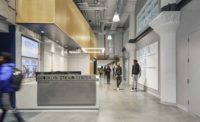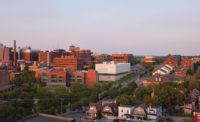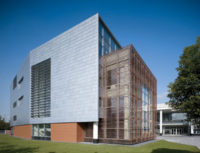Why make a school building circular? For the Charter Oak elementary school (named after Connecticut’s official state tree), the answer can be explained by its philosophy. As an International Baccalaureate (IB) school, its curriculum is closely aligned with the United Nations’ mission of fostering world peace. Established in 1968 in Geneva, the IB program—offered at close to 1,700 primary and secondary schools, both public and private, in the United States alone—teaches students to make connections between conventional coursework and international issues. Face-to-face interactions are an integral part of study; just as diplomats often convene in a ring-shaped formation at the U.N. building, students gather regularly for discussions in the round. So when architects from Perkins Eastman presented possible configurations for the new facility to Charter Oak faculty and parents, the symbolism of a circular plan clicked.
Additional Content:
Jump to credits & specifications
Conceived as a “pavilion in the park,” the 83,500-square-foot building sits on a 9.5-acre lot surrounded by traditional suburban houses. Playgrounds and outdoor learning spaces wrap around the building’s south, east, and north sides, with a parking lot and large grassy field to the west. In the interest of keeping it in scale with the neighborhood, the school rises as high as two stories only where it is farthest from residences. On the south, where it sits closest to a main intersection and houses, the building is one level (pre–K and kindergarten occupy the ground floor; in the northern, higher part, grades one through five are above). Its curved shape diminishes perception of its size, which is revealed slowly as one walks around it, either inside or out.
The new doughnut-shaped structure replaces a 1930s concrete-framed Art Moderne building with a 1970s rectilinear addition, located on what is now the parking lot. As a nod to its predecessor, it is clad in brick of a similar orange, though its structural system is steel. When the project was completed in 2016, the historic building was razed. Although the community found it endearing, the former school was dark and constraining, and wasn’t attracting the desired enrollment. (As a public magnet school, it has a lottery system through which town residents can be chosen to attend.) State funds financed the project.
From the planning stage, input from the community was crucial to the design. The architectural team found that children and parents sought similar qualities in the new school: natural light, connections to the outdoors, and variety in the design of spaces. All of the classrooms, along the inner and outer perimeter walls, feature generous glazing; other areas, such as the courtyard, teaching garden, media center, and small rooms for individual instruction, provide alternative teaching environments. “Throughout the duration of the project, the children were involved, and that’s powerful,” says Kate Jerram, Charter Oak’s curriculum specialist. In line with the IB philosophy, the construction of the new school served as an educational opportunity for students, who met with the architects on a regular basis to learn about the building’s development.
Another important consideration was connecting the school’s occupants to nature. The central courtyard provides a lush setting of regional plants for learning, respite, and passage from one side of the building to the other (tricycles are a popular mode of transportation). An outdoor amphitheater becomes an extension of the (indoor) auditorium when the double-height glazed door at the stage’s rear is lifted.
References to nature, particularly oak trees, also abound on interior surfaces: the windows of the auditorium and library, facing one another in the courtyard, feature designs of branches, the first as a frit on the glazing, the second in perforated metal screening; acoustic panels in both double-height spaces take the form of leaves; the hallways and classrooms pop with green-painted doorways and walls, and occasional wood paneling. Fitting with the curriculum, which incorporates the values of sustainability, Charter Oak is a LEED Gold–certified building with a geothermal heating system and a solar panel array on the roof.
Now in its second year, Charter Oak is already seeing the benefits of its new facility. The retention rate from pre–K to kindergarten increased to 100 percent, and the school district received over 400 requests for admission for the 2017 school year, up from the usual 100. And, according to teachers, children seem happier. “The building has a very dynamic feel,” says principal Juan Melián. “I’m not an architect, but it is serving us very well.”
CreditsArchitect: Perkins Eastman 422 Summer Street Stamford, CT 06901 203 251 7400 www.perkinseastman.com
Personnel in architect's firm who should receive special credit: Joseph Costa AIA, Principal In Charge Mark McCarthy AIA, Design Principal Michael Berger AIA, Design Architect Frtiz Morris AIA, Project Manager Joseph Culotta AIA, Project Architect Liz Lee RA, Programming Lauren Giamundo Matthew Hoffman Jon Seibert RA, Construction Support Architect Leia Cadotte, Interiors Helene O’Dwyer-Garcia, Interiors
Architect of record: Perkins Eastman 422 Summer Street Stamford, CT 06901 203 251 7400
Interior designer: Perkins Eastman
Engineers Civil/Structural/Mechanical/Plumbing/FireProtection Engineers: BVH Integrated Services, P.C. Traffic & Surveyors: Milone & Macbroom Geotechnical Engineers: Welti Associates Geothermal Engineers: GZA Geoenviornmental Environmental Engineer: Diversified Technology Consultants
Consultants Landscape Architect: Richter & Cegan, Inc. Sustainability Consultant: Atelier Ten Food Service: Foodservice Facilities International Acoustics: Brooks Acoustics Corporation Information Technology/ Security / Telecommunication Consultants: D’Agostino & Associates
Construction Manager: Fusco Corporation
Owner’s Program Manager: Construction Support Group, LLC
Photographer: Robert Benson Photography |
SpecificationsExterior Cladding Masonry: Brick: Watsontown Brick Co. Metal panels: Morin & Alucobond Metal/glass curtain wall: EFCO Curtain wall: EFCO Perforated Decorative Metal Panels: Alcatop International
Roofing Built-up roofing: Johns Manville
Windows Metal frame: EFCO
Glazing Glass: Oldcastle BuildingEnvelope Skylights: Wasco Products Sunshades: CS Group
Doors Entrances: EFCO and Wood doors: Graham Wood Doors Upward Acting doors: Renlita Overhead Doors
Hardware Locksets: Corbin Closers: LCN Exit devices: Corbin Electric Strikes: Von Duprin
Interior Finishes Acoustical ceilings: Armstrong Ceilings Suspension grid: Armstrong Ceilings Cabinetwork and custom woodwork: Legere Group, Ltd Paints and stains: Sherwin Williams Wall coverings: Wolf Gordon Plastic laminate: Wilsonart, Formica, Chemetal Solid surfacing: Dupon Corian, Avonite Studio Collection Special surfacing: Depaoli Mosaic Company – Terrazzo Flooring Floor and wall tile: Daltile, Stone Source Resilient flooring: Azrock Color Essence Carpet: Shaw and Interface
Furnishings Office furniture: Steelcase Reception furniture: Steelcase Fixed seating: Steeldeck NY Chairs: Freshcoast, Community Playthings, Acadia, V/S, Tenjam, Hightower Tables: Paragon, Community Playthings, Hertz, Steelcase, School Specialty, Sisco Other furniture: Beyondplay.com, BCI, Blick, Joy Carpets, Gopher
Lighting Interior ambient lighting: WASCO Skylights Downlights: Gammalux Lighting Systems, Cooper Lighting, Spec Grade Tasklighting: Cooper Lighting Exterior: Cooper Lighting
Conveyance Elevators: Kone
Plumbing Faucets: Chicago Faucets Flushometers: Coyne & Delany Co. Water Closets: American Standard Urinals: American Standard Lavatories: American Standard Sinks: Advance Tabco
Energy Energy management or building automation system: Alerton Ascent Photovoltaic system: Summer Hill Solar
Add any additional building components or special equipment that made a significant contribution to this project: Geothermal Well Field |














Post a comment to this article
Report Abusive Comment